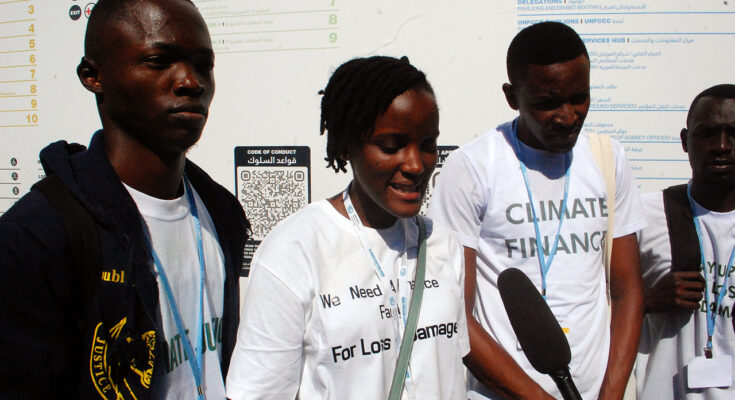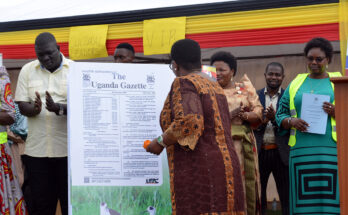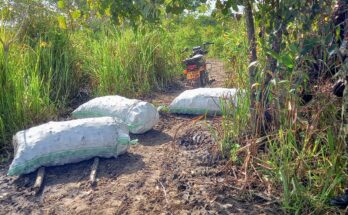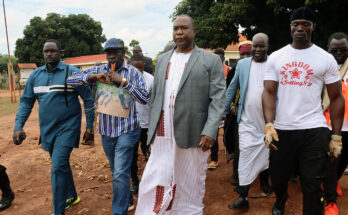PHOTO: Climate activist, Vanessa Nakate, speaks at the recent COP27 in Sharm el-sheikh, Egypt. PHOTO BY JOHN OKOT
Last month a flurry of excitement emanated from Sharm el–sheik, reverberating across the Red Sea, then globally. For the first time in history, after protracted negotiations that went into extra time during the recent COP27, more than 200 nations finally agreed to create and operationalize the hard-fought “loss and damage” fund to support developing nations that are particularly vulnerable to climate change.
“This is a big step for us. Now the main task is to push so that nations that are suffering from climate change caused by the biggest [carbon] emitters are helped,” said Vanessa Nakate, a renowned climate activist and Goodwill Ambassador for the United Nations Fund (UNICEF). “This needs to happen fast”.
For many communities hard-hit by climate crises, Nakate’s message resonates well. In Uganda for instance, famine continues to stalk the Karamoja region due to prolonged dry spells, and further afield in eastern Uganda, people are still reeling from effects of landslides that hit Bududa district in August that left more than 300 people homeless and properties – houses, crops and animals- buried.
And worse still, these crises are happening almost everywhere which is “a clear proof that we need the loss and damage fund to operate as soon as yesterday,” cautioned Botswana president Mokgweetsi Masisi before the end of COP 27. But two weeks later, after he remarks, communities in Lagos, Nigeria, were also hit hard by floods, displacing more than 2,000 households.
Back to the “loss and damage” deal. Now that it was agreed, what are the sticking points so far?
- Payment mechanism- and who pays what?
Despite agreeing on a “loss and damage” fund, there are areas that need to be ironed out between the Global North and the developing world. The recent deal did not give specific details regarding when and how much funds would each developed nation contribute to the fund. The deal left much of the heavy lifting – still like the previous meeting – for COP28 next year. However, one thing for sure, is the Global North bears the most responsibility to compensate for losses caused due to climate change. Still, their previous commitment to fulfil a pledge made has not lived up to scratch. In 2010, Global North pledged to contribute 100 billion USD every year by 20202 to support developing countries to adapt to climate shocks. In 2020, however, wealthy nations had pledged just 83 billion USD. This pledge is still hanging.
“It has to be paid as we move on,” said Ephraim Shitima Africa’s chief negotiator, “The loss and damage fund is just an additional pledge”.
Despite the perks from the recent COP27, the downside is that developing nations continue to battle impacts of climate change, and Mr. Shitima is worried that it would take “a very long time” before the funds start operating. And when it does finally, he adds, there has to be a structured payment mechanism that will ensure there is transparency and proper management of the funds.
Sven Harmeling, global policy lead on climate change and resilience at CARE International, however, believes that from 2025 onwards, the fund may be able to release the first payments and gradually be built up on that.
“It’s not about industrialized countries saving the whole planet. We are beyond that state. But I think it’s an element of fairness that we finally pay loss and damages to those many, many people who suffer in their daily lives out of a crisis which they have hardly contributed to,” Harmeling said.
- Gender inclusiveness
Women representation at the recent COP27 became a thorny issue as it shined a spotlight on the underlying inequality issues. The BBC analysis indicates that women made less than 34% of country negotiating teams at COP27.
Studies show that marginalized groups like women experience the greatest impacts of climate change, which poses unique threats to their livelihoods such as agriculture and health, yet they have less access to natural resources despite being the most dependent on them.
This portrays a grim situation, gender activists say, adding that more women need to be at the helm of climate talks since they are the most affected by the negative impacts of climate change.
Omar Manna, a Kenyan activist, says, “having women in key decision spaces helps to amplify their voices on key climate issues which affect them the most”.
Belinda Okungu, Gender Advisor at the Pan African Climate Justice Alliance (PACJA) “remains vague because it has to extensively highlight how women can be supported because they are often affected severely”.
In Uganda, around Buliisa district, for instance, many women rely mostly on agriculture, but the East African Crude Oil Pipeline (EACOP) has ripped through most of their gardens. The rising number of extractive industries by foreign investors, exacerbated by factors like tax incentives given the government, has not made things better. As a result, many women are struggling to survive since their source of livelihood, agriculture, is stake. This led to the rise of rights-based groups calling for redress due to the rising environmental and human rights concerns.
- The fossil fuel question
During COP26 in Glasgow, nearly 200 countries pledged to end public finance for fossil fuels by the end of 2022; and 9 countries and institutions signed a joint commitment on “International Public Support for the Clean Energy Transition” (the Glasgow Statement) to end any support for fossil fuels flowing abroad by the end of 2022. The goal was to keep 1.5 degrees alive with scientists warning that going beyond that threshold would spur climate change to the extreme.
Despite the “loss and damage” deal this year, the fossil phases used in COP27 left a bitter taste in the mouth of the climate observers and negotiators. The language used was calling for ‘low carbon emission’ – which was different from the previous COP26 talks that called for a complete phase out of fossil fuel. This caused friction among negotiators who accused each other of bad faith and “hypocrisy”.
But the continued use of fossil fuel and failure to push as well as implement a just and equitable phase out of fossil fuel is dangerous, experts say. Uganda for instance, remains determined to complete the world’s longest heated oil pipeline, EACOP, despite several environmental concerns as activists push hard for institutions to defund it. The 1,443 km oil pipeline will generate 34 million tonnes of carbon each year thus increasing Uganda’s annual emissions by a factor of seven. Uganda’s carbon emissions have had a steady rise increasing from 53,000 tonnes of carbon in 2005 to close to 90,000 in 2015
The demand for coal and gas by European countries that used to depend on Russia for the supply is high. Since September this year, many European countries have been scampering for alternative sources of coal energy in the global south after Russia halted gas supplies. Uganda’s president, Yoweri Museveni, has castigated the countries of ‘reprehensible double standards’ and for ‘making a mockery’ of climate targets after they revived coal-based energy as an alternative to Russian energy.
Amid all that, for some time, there have been strong calls for all governments across the globe to negotiate a fossil fuel non-proliferation treaty as an international mechanism that can complement on meeting the Paris Agreement/s goal of keeping the 1.5 degree Celsius alive.
“The treaty will phase out existing productions and prevent proliferation by ending exploration of coal, oil and gas for very country thus scaling up renewable energy use” Zeporaah Berman, a Canadian climate activist, who called upon counties to agree on the
“As of now, over 3,000 scientists and academics from 69 countries have already endured the treaty”.




